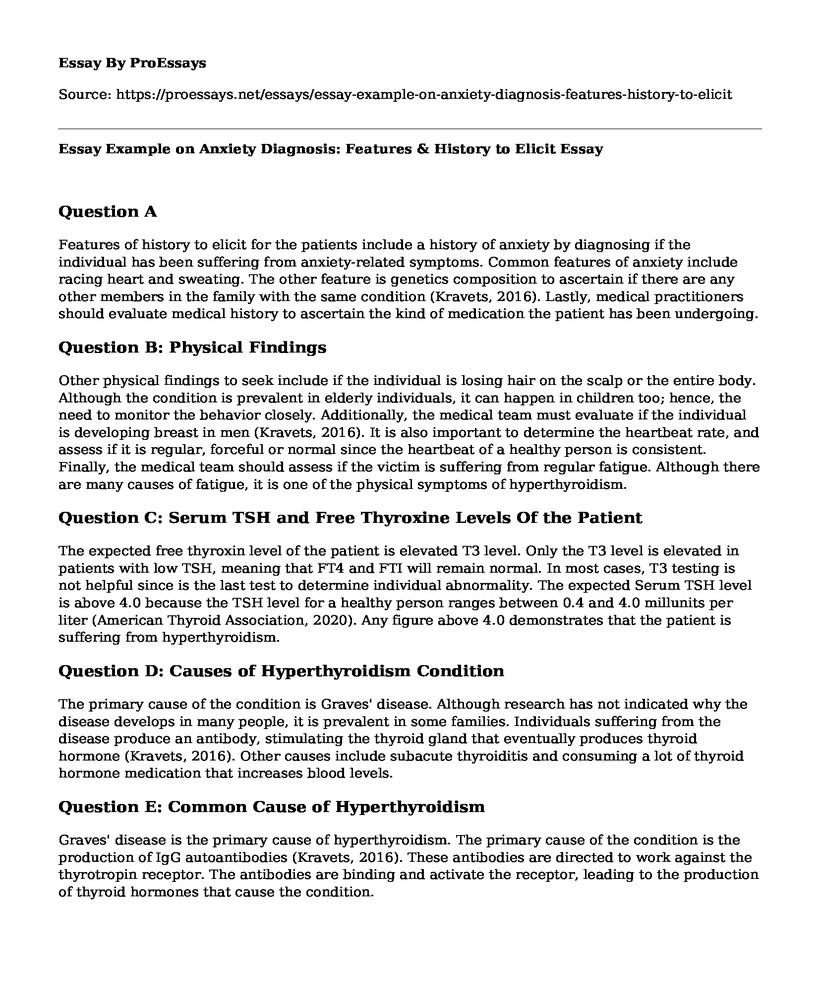Question A
Features of history to elicit for the patients include a history of anxiety by diagnosing if the individual has been suffering from anxiety-related symptoms. Common features of anxiety include racing heart and sweating. The other feature is genetics composition to ascertain if there are any other members in the family with the same condition (Kravets, 2016). Lastly, medical practitioners should evaluate medical history to ascertain the kind of medication the patient has been undergoing.
Question B: Physical Findings
Other physical findings to seek include if the individual is losing hair on the scalp or the entire body. Although the condition is prevalent in elderly individuals, it can happen in children too; hence, the need to monitor the behavior closely. Additionally, the medical team must evaluate if the individual is developing breast in men (Kravets, 2016). It is also important to determine the heartbeat rate, and assess if it is regular, forceful or normal since the heartbeat of a healthy person is consistent. Finally, the medical team should assess if the victim is suffering from regular fatigue. Although there are many causes of fatigue, it is one of the physical symptoms of hyperthyroidism.
Question C: Serum TSH and Free Thyroxine Levels Of the Patient
The expected free thyroxin level of the patient is elevated T3 level. Only the T3 level is elevated in patients with low TSH, meaning that FT4 and FTI will remain normal. In most cases, T3 testing is not helpful since is the last test to determine individual abnormality. The expected Serum TSH level is above 4.0 because the TSH level for a healthy person ranges between 0.4 and 4.0 millunits per liter (American Thyroid Association, 2020). Any figure above 4.0 demonstrates that the patient is suffering from hyperthyroidism.
Question D: Causes of Hyperthyroidism Condition
The primary cause of the condition is Graves' disease. Although research has not indicated why the disease develops in many people, it is prevalent in some families. Individuals suffering from the disease produce an antibody, stimulating the thyroid gland that eventually produces thyroid hormone (Kravets, 2016). Other causes include subacute thyroiditis and consuming a lot of thyroid hormone medication that increases blood levels.
Question E: Common Cause of Hyperthyroidism
Graves' disease is the primary cause of hyperthyroidism. The primary cause of the condition is the production of IgG autoantibodies (Kravets, 2016). These antibodies are directed to work against the thyrotropin receptor. The antibodies are binding and activate the receptor, leading to the production of thyroid hormones that cause the condition.
Question E: Pathogenesis
Excess production of thyroid hormone leads to palpitations and intolerance to exercises because of the increased heart rate and fatigue. An unstable supply of blood from the heart also causes tachycardia. Also, it causes weight loss because of the association between thyroid hormone and basal metabolic rate. As a result, the body burns and consumes more energy even at rest; thus, causing weight loss. Additionally, the condition causes an increase in glycosaminoglycan deposition and deposition of dermal acid, causing skin change (LiVolsi & Baloch, 2018). The antibodies attack the thyroid gland, increasing the production of thyroxine; thus, causing goiter. Increased production of thyroid hormone thyroxine breaks down muscle tissues, causing muscle weakness.
Treatment Plans
The first treatment of the condition is medication. The patient should be put on antithyroid drugs to manage overactive thyroid and the treatment can last for almost two years to determine if the drugs resolve the condition. Antithyroid treatment drugs to use include methimazole and propylthiouracil (American Thyroid Association, 2020). The second way to manage the condition is surgery, which is the removal of thyroid and this can be a permanent solution for hyperthyroidism. However, it should come as the second option if treatment fails to manage the condition.
References
American Thyroid Association. (2020). Thyroid function tests. Retrieved from https://www.thyroid.org/thyroid-function-tests/Kravets, I. (2016). Hyperthyroidism: Diagnosis and treatment. American Family Physician 1;93(5), 363-370.
LiVolsi, V., & Baloch, Z. (2018). The pathology of hyperthyroidism. Frontiers in Endocrinology, 9(737), 1-8.
Cite this page
Essay Example on Anxiety Diagnosis: Features & History to Elicit. (2023, Apr 23). Retrieved from https://proessays.net/essays/essay-example-on-anxiety-diagnosis-features-history-to-elicit
If you are the original author of this essay and no longer wish to have it published on the ProEssays website, please click below to request its removal:
- Walking Speed Differences Following Open Heart Surgery Vary with Discharge Destination
- Multimodal Medium Essay: Need for Personal Fitness
- Cancer: What I Knew as a Secondary School Kid - Essay Sample
- Research Paper on Deviance: Excessive Gambling, Alcoholism & More
- Essay Sample on Components of the Memory System: An In-Depth Analysis
- Navigating Covid Crisis: A Decision-Making Model - Essay Sample
- Essay Example on Women Expressing Love: How It Has Changed Since the 19th Century







